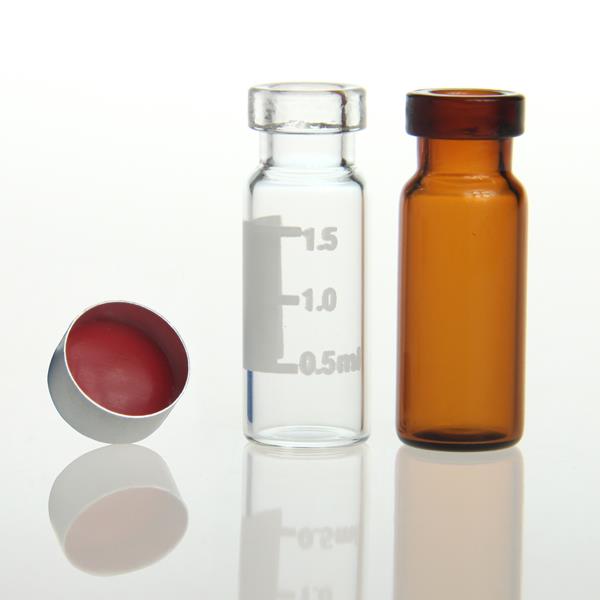Headspace Vials vs. Regular Sample Vials
🔥 Introduction
In analytical chemistry and laboratory testing, sample vials are used as the basic containers for carrying substances to be tested, and their selection directly affects the accuracy and reproducibility of test results. Whether in gas chromatography, liquid chromatography, environmental monitoring, pharmaceutical testing, etc., the material, sealing, pressure resistance and other characteristics of the sample vial need to be strictly matched with the experimental method. However, in the face of diverse experimental needs, how to scientifically select sample bottles has become a key link in experimental design.
The purpose of this paper is to compare the differences between headspace vials and ordinary vials in terms of structure, material, and application scenarios, to help experimentalists choose the optimal containers according to the testing objectives, and to improve the experimental efficiency and data quality.
🔥 Basic Concepts of Headspace Vials and Normal Vials
1. Headspace vials
Structural features
-
- Cushion material: need to withstand high temperature heating (usually 40 ℃ -200 ℃) generated by the internal pressure, to prevent bursting or leakage.
- Special cap design: the spacer is made of PTFE/silicone composite mat, which is high temperature resistant and low adsorption to avoid volatile components being adsorbed or contaminated. The sealing method is usually aluminum gland or screw cap to ensure air tightness.
- Volume accuracy: standard specifications (10ml, 20ml), reducing errors in the headspace equilibrium stage.
- Bottle material: high borosilicate glass (thermal shock resistant) or amber glass (protected from light to protect light sensitive components).
2. Plain vials
Used for routine storage, transportation and injection of liquid or solid samples, not involving high pressure volatile component analysis.
Structural features
-
- Bottle mouth design: generally standard threaded mouth or bayonet, suitable for autosampler. Spacer is optional, but the sealing requirement is lower than that of headspace bottle.
- Variety of materials: clear/amber glass (e.g. borosilicate glass, chemically resistant), plastic bottles (for non-organic solvents or low-cost scenarios).
- No pressure resistance required: usually not used in high temperature and pressure environments, simpler construction, lower cost.
🔥 The Main Differences Between Headspace Vials and Ordinary Sample Vials
Headspace vials and regular sample bottles differ significantly in several key dimensions that directly affect their suitability for experiments. The following is a detailed comparative analysis from the aspects of sealing, cap design, volumetric accuracy, and applicable technology:
1. Sealability
One of the core characteristics of headspace vials is their high pressure tightness. Since headspace analysis involves heating the sample at high temperatures (typically 40°C-200°C) to allow volatile components to escape into the headspace, the vial must be able to withstand the increased internal pressure while being completely protected from gas leakage. This stringent sealing requirement cannot be met by ordinary samples.
In contrast, the seals on regular vials are designed primarily for liquid leakage prevention and are suitable for routine storage and injection operations. Although some of these vials also utilize PTFE spacers, their sealing performance is significantly degraded at elevated temperatures and pressures, making them unsuitable for headspace vials.
2. Cap design
Headspace vials are typically designed with aluminum caps or reinforced threaded caps with a special PTFE/silicone composite spacer. This combination ensures that the spacer does not deform at elevated temperatures and prevents the adsorption of volatile components. Aluminum caps are mechanically stronger, so they can be used to plan the puncture operation of the headspace autosampler at that time.
Standard screw caps or snap-on caps are used for the most common vials, with a choice of PTFE, PE, or silicone spacer materials. Although these designs are less costly, problems such as softening of the spacer and seal failure can occur at high temperatures. In addition, ordinary caps are less resistant to disassembly, which can lead to sealing performance degradation after repeated sample feeding.
3. Volume accuracy
Headspace vials require extremely strict volumetric accuracy because headspace analysis relies on gas-liquid equilibrium, and small differences in the volume of the sample in the vial will directly affect the concentration of the target in the gas phase, which will lead to deviations in the analytical results. High precision volume ensures the repeatability and comparability of the experiment.
Ordinary sample bottles have a larger allowable error in volume, because they are mainly used for liquid storage or direct injection, the volume difference has less impact on the test results.
4. Applicable technologies
Headspace vials are designed for headspace gas chromatography and are suitable for the detection of volatile or semi-volatile components in samples.
Plain vials are widely used for liquid/solid sample injection in liquid phase techniques for routine gas chromatography.
5. Material and pressure resistance
Headspace vials are usually made of high borosilicate glass or amber glass. The purity of the material is increased to avoid adsorption of volatile components. The construction is designed to withstand internal pressure to prevent bursting when heated.
Plain vials are available in more flexible materials, including clear/amber glass or plastic. Plastic bottles are low cost but are only suitable for non-organic solvents or short-term storage. Plain glass vials are less pressure resistant and may break at high temperatures.
6. Cost variances
Headspace vials are more expensive per unit due to special materials, high precision manufacturing and seal design.
Ordinary sample bottles are highly standardized, with low production costs, and are suitable for large-scale routine use.
🔥 Application Scenarios for Headspace Vials
Headspace vials play a key role in many areas where volatile components need to be detected due to their excellent sealing, pressure resistance and low adsorption properties. The following are typical application scenarios:
1. Volatile Organic Compounds (VOCs)
The gold standard for analyzing VOCs in environmental testing, the headspace injection chamber is suitable for:
-
- Environmental water samples: Detection of benzene, halogenated hydrocarbons and other pollutants in groundwater and surface water, with sensitivity up to ppb level.
- Air monitoring: thermal desorption to headspace bottles after sampling through adsorption tubes to analyze formaldehyde, BTEX, etc. in the atmosphere.
- Blood Alcohol Detection: Precise determination of blood ethanol concentration by headspace GC in forensic and traffic enforcement.
2. Residual solvent analysis
Headspace vials are used for compliance testing in the pharmaceutical and packaging industries:
-
- Pharmaceutical manufacturing: Detection of residual Class I (e.g. benzene), Class II (e.g. methanol) solvents in APIs or formulations according to USP<467> and EP 2.4.24 standards.
- Packaging materials: Evaluation of volatile additives (e.g. cyclohexanone, isopropanol) migrating in food and pharmaceutical packaging (e.g. plastic, aluminum foil).
3. Food flavor studies
Headspace technology allows for the non-destructive extraction of aroma components from food products:
-
- Wine analysis: identification of esters, aldehydes and other flavor substances in wine and liquor.
- Dairy products: detection of short-chain fatty acids and other sources of off-flavor in cheese and butter.
- Packaged foods: study of changes in volatile flavor substances during shelf life.
4. Forensic medicine and toxicology
Headspace GC-MS is used in criminal investigations and clinical toxicology:
-
- Screening of volatile toxicants: markers of poisoning such as methanol, isopropanol and chloroform in blood and urine.
- Drug of abuse detection: e.g. THC (cannabis component) in exhaled breath or volatile inhalants.
- Decay product analysis: quantification of decay gases such as cadaveric amines and putrescine in cadaver blood.
🔥 Application Scenarios for Common Sample Vials
1. High performance liquid chromatography (HPLC) analysis:
Plain sample vials are widely used for the injection system in HPLC instruments. Due to its good sealing and material compatibility, it is suitable for most polar and non-polar solvents. Researchers can add liquid samples directly into the vials and inject them quantitatively through the autosampler to improve the reproducibility and efficiency of experiments.
2. Routine sample storage:
In chemical, biological and other laboratories, general sample bottles are often used as short or medium-term storage containers for routine samples. It is suitable for storing liquid chemical reagents, organic solvents, standard solutions, and temporarily prepared buffers or reagent mixtures. It can also be used to store some non-volatile solid powders or lyophilized products.
3. Handling of non-volatile analytical samples:
For non-volatile analytical objects such as protein solutions, peptides, biological macromolecules, inorganic ions, water-soluble drugs, etc., plain sample bottles provide a safe and clean storage environment. Combined with different types of caps and spacers, they can prevent contamination and cross-interference and are suitable for subsequent mass spectrometry, electrophoresis or spectroscopic analysis.
4. General laboratory operations:
In daily scientific work, common sample bottles can be used for dilution, mixing or short reaction operation of small amount of liquid. Their standardized volume design and transparency make it easy to observe the process. It is also often used by laboratory personnel for temporary storage of samples after pre-treatment.
5. Quality control and sample management:
In pharmaceutical or food companies, common sample bottles are often used for batch sampling, stability test sample storage and quality tracking to ensure data traceability. The bottles are easy to label for record keeping and easy to file and manage.
6. Teaching and demonstration experiments:
In educational institutions and scientific research training, sample bottles are widely used in experimental teaching and demonstration of experimental skills because of its simple operation and low cost.
🔥 How to Choose the Right Sample Bottle
In laboratory analytical work, the correct choice of sample vials is not only related to the accuracy and reproducibility of data points, but also affects experimental efficiency and cost control. Sample vials should be selected by taking into account factors such as detection method, sample characteristics and experimental budget.
1. Selection based on detection method
Headspace analysis: If headspace injection technique is used, special headspace vials should be selected. These bottles have high temperature resistance, excellent sealing, and can effectively isolate the liquid and gas phases under heating conditions to ensure that the gas phase portion of the collection of representative.
Conventional liquid injection: For analytical scenarios where liquid samples are injected directly through HPLC, GC and other techniques, ordinary sample bottles are sufficient to meet the needs. Its structure is adapted to the autosampler, which can complete the sample injection process efficiently.
2. Selection according to the nature of the sample
Volatile or heated samples: If the sample is volatile or requires heating, the use of headspace vials is recommended. These bottles are usually made of high borosilicate glass, which can withstand high temperatures and internal pressures, and with PTFE/silicone composite gaskets to provide excellent airtightness to prevent volatile loss or contamination of the sample.
Non-volatile, room temperature samples: For protein solutions, water-soluble inorganic salts, biological buffers can be non-volatile or room temperature treatment of samples, ordinary samples can be competent, to avoid waste of resources, suitable for large quantities of preparation and repetitive testing.
3. Trade-off between cost and experimental requirements
Cost considerations: headspace bottles are usually more complex manufacturing process, higher material requirements, the price is relatively high; but its professional performance is suitable for specific application scenarios, if the experiments on the sample closure, volatile loss control requirements are stringent, should be given priority.
Experimental versatility: ordinary sample bottles are widely used in routine testing and teaching experiments due to their low price, simple structure and strong adaptability. If there is no special demand, give priority to the use of ordinary bottles to control the cost of experimental consumables.
Compatibility of accessories: When choosing sample bottles, you should also pay attention to whether they are compatible with the existing autosampler, cap and gasket system, so as not to affect the efficiency of sampling or cause equipment jamming.
🔥 Conclusion
In the modern laboratory analysis process, the sample bottle as a sample pre-treatment and analysis of the key consumables in the injection, the selection of its direct impression of the conceptual unit of the accuracy of the experimental results, ease of operation and the efficiency of the use of experimental resources.
Therefore, mastering the performance characteristics of different types of sample bottles and their application scenarios is the basis for guaranteeing scientific and effective analysis results and reasonable allocation of experimental resources.

 Italiano
Italiano Português
Português
